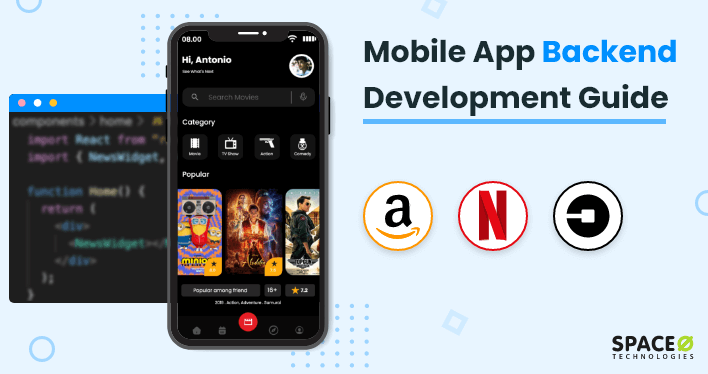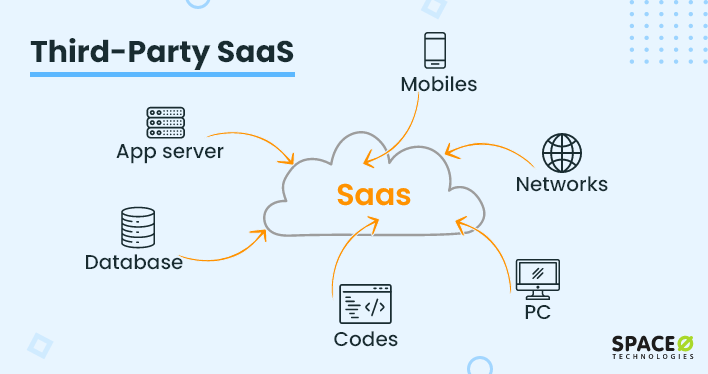Being an entrepreneur, you understand how a powerful backend influences the performance of an app.
There is no extra logic; if you don’t build a robust backend, your app simply might not function appropriately and can actually impact the app’s performance.
When already the competition is fierce and millions of apps are available for download, you need to stand out with your app. If you are someone who really believes in offering the best services or performance to the app users, then you need a strong backend for your app development project.
The backend works exactly the same as powerful engines for a rocket. Being a top mobile app development company, we have gathered all of this information after discussing it with our experienced app development team. If you are wondering how to build a backend for a mobile app, then you’ve landed at the right place. This blog talks about the various ins and outs of backend development. Let’s get started.
Table of Contents
- What is Backend in Mobile App Development?
- What are the Types of Mobile App Backends?
- How Does the Mobile App Back-end Work?
- What Type of Apps Require Backend Development?
- What Type of Apps Doesn’t Require a Backend?
- Backend Technology Stack
- Tools Used in Mobile App Backend Development
- Mobile App Functions That are Provided with Backend Development
- FAQ About Mobile App Backend Development
- Implement a Strong Backend in Your App
What is Backend in Mobile App Development?
Mobile backend development is responsible for processing data, business logic, and security of an application. Backend development includes servers, middleware, and databases and it is accessible via an API (application programming interface).
A backend of a mobile app takes care of:
- Processing and storing data for a smartphone device
- Syncing and sharing data across multiple devices and platforms
- Updating content with the mobile app
- Managing the business logic of an app
- Authorizing and authenticating the control access of data
Being a mobile backend developer, you may question yourself, how to create an app from scratch? To understand the entire app development process, you need to have knowledge of backend development as well.
The mobile backend runs on a remote server and is used for communication between the machines and servers. An app’s mobile backend processes certain tasks to improve your front-end experience and is easily accessed via APIs (application programming interface).
The backend helps you process heavy operations.
For example, when you open Spotify to listen to songs, the backend of the Spotify app tries to retrieve songs because of the limited capabilities of smartphones.
In short, the backend makes it easy for you to listen to your favorite songs by retrieving the end number of songs.
With this example, we are also going to discuss a few types of apps that require backend support to get operated. Check the next section for this.
What are the Types of Mobile App Backends?
Now you are aware of the functioning of the mobile backend, check the various types of app backends. All the mobile backend solutions serve different mobile app development demands and offer business logic.
In this section, we are going to discuss the three types of mobile app backends in detail.
Third-Party SaaS

The solution you want to build might already be launched in the market. That means they have already built a backend from scratch for their apps.
Some apps or platforms offer you to connect your front end to their backend on a subscription fee model, where you will charge to pay on a monthly or yearly basis.
This method plays a role as a plug-and-play solution, where you plug in your front-end part of the mobile app to their backend on a subscription fee model and release your app. Such solutions are known as third-party mobile app backend or SaaS solutions.
MBaaS Solutions
You need strong backend solutions that help you store user data and offer advanced features like login/registration, authentication, and push notifications.
All you can do is either develop an app to use as a backend or use existing MBaaS (Mobile Backend as a Service). This not only saves you time but also helps you reduce mobile app development costs to an extent.
MBaaS offers you pre-developed components with a backend that you can use to implement all the advanced features. In fact, you are allowed to have your own custom code functionalities outside the available libraries and components.
With this, backend developers don’t need to create a backend from scratch but leverage reusable components and pre-populated libraries. In this solution, app owners need to pay a monthly fee for the usage of services, such as notifications sent and an increasing number of users.
Custom Backend
You need a custom backend if you want full flexibility and customization in your mobile app. You will require to build the backend from scratch so that you can offer custom features to your app users.
However, when it comes to customizing a backend, you might need to pay a huge price to the developers or invest in underlying infrastructure. But the custom backend is worth the cost if you are building an app that has to offer high performance and security to the app users.
If the performance and security of the app are in your mind, then you need to build a custom backend using the right tech stack. Also, you can go for a hybrid approach with a mix of SaaS, MBaaS, and custom backend solutions.
If you are now looking for the best backend tech stacks, then go ahead reading the next section. In the following section, we have discussed the top technology stacks for the iOS and Android backends.
Want to Build an App Like Uber Having a Strong Backend?
Space-O is a leading mobile app development company in the USA to build more than 4400 apps for industries such as on-demand, eCommerce, and manufacturing.

How Does the Mobile App Back-end Work?
If the front end of an app that you see in your app is a body, then the back end is the soul of the mobile application. The backend app communicates with the front end to answer a user’s requests.
Without the backend, the front end will not function.
And without the front end, a user won’t be able to understand the functionalities of an app.
But how do these front end and back end communicate with each other and understand the requests of a user?
The backend and frontend communicate with each other via APIs.
Whenever a user taps on their app screen, the front end understands the request and sends it to the backend. On the other hand, the backend of the app retrieves the information which was requested to perform via an API and sends it back to the front end to display the information.
Let’s understand this with an easy example:
You are purchasing a dress online, and you have finalized it, and now you want to make a payment for it. Supposedly, you will click on the ‘Buy Now’ button and get redirected to the checkout page to choose one payment option.
Now the front end of the app will send a request to the backend servers to connect with an external payment gateway. If successfully done, you instantly see a banking page that will ask you to enter your credential details, such as card number, name, and CVV, for secured payment.
This communication is done by the API, which connects the front end and the back end of the mobile application to the external service (payment provider) to help you view the payment page.
The communication between both the front end and the back end ensures that the app functions seamlessly and is able to offer the expected solution to the users. In this case, you are able to purchase a dress while making an online payment.
What Type of Apps Require Backend Development?
Mobile apps that store user data allow for login/registration features, and authentication, and offer login/registration features that require a backend.
Let’s quickly discuss such apps to find out why they need backend support.
Netflix
Netflix is a streaming service provider for watching and downloading movies and TV series. Netflix has an admin panel (backend), allowing admins to manage videos available to users. It also requires the backend to allow app users to sign into their accounts. Here are the programming languages used by Netflix.
Programming Languages Platform and Storage Java AWS S3 Python AWS EC2 Nodejs AWS Lamda React – RxJS – Amazon
Amazon is an eCommerce site that also needs a backend to manage information on several products that get uploaded on a regular basis. With the help of the backend, this great online marketplace gets the ability to add, remove, and refresh the product list in order to give the best shopping experience to the users. The following table includes the programming languages, platform, and storage Amazon uses to power its mobile app.
Programming Languages Platform and Storage React Amazon S3 Java Amazon EC2 AngularJS Amazon CloudFront – Amazon DynamoDB – MySQL Uber
Uber is an on-demand taxi booking service app that also needs a backend to help app users find a nearby car. It is easy for you to find a car and reserve it to take wherever you like. Hence, the app needs a backend for this to help you place a ride or cancel it. Here are the programming languages, platforms, and storage Uber uses.
Programming Languages Platform and Storage Python Amazon EC2 Node.js Amazon S3 Go – Java – C & C++ to Write Tools –
Even though the mobile app backend plays a crucial role in operating an app, there are a few types of applications that don’t require a backend at all.
Yes, you heard it right. We will discuss such types of apps in the following section.
Using the top mobile app technologies, one of our clients wanted to develop a VPN app that allows him to access restricted websites from across the globe. The client contacted our mobile app development team and discussed his requirements with us. Here is how the TOR VPN works.
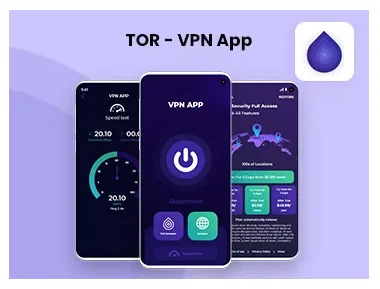
The TOR app was developed by our Android app developers. It allows internet speed testing and provides the best VPN service globally. The TOR app has been downloaded by 100K+ users in less than a year and has an overall rating of 4.3 stars.
What Type of Apps Doesn’t Require a Backend?
There are a few app types that function without a backend.
However, let’s quickly find some of the apps that you use in your daily lives that don’t need a backend at all.
Calculator
The Calculator app is already pre-installed on your mobile device; you don’t need to install it via the app store. You easily use the Calculator app to perform basic mathematical operations with no involvement of any backend.
Voice Recorder
Just like the Calculator app, Voice Recorder is also pre-installed on your mobile device to use as a dictaphone. This app functions to record your voice note using the microphone and stores the recording on your device’s local storage. So again, you don’t need a backend to operate the Voice Recorder app.
Measure
This Measure app is already pre-installed on iOS devices. Hence, you easily measure the dimension of any object using your phone’s camera without installing them via the Apple App Store. For this, too, you don’t need a backend.
Camera
The Camera app is already installed by default on all smartphones. You use it to capture pictures and record videos. Therefore, it doesn’t require a backend to operate. However, there are some of the latest camera apps which use backends to open GPS while using the camera or to store backups of taken photos to prevent losing data.
Now, you know which apps require a mobile backend and which apps don’t. You must be curious to know how a backend functions. So without any delay, let’s discover how a backend works in a mobile app.
Backend Technology Stack
To build a strong backend, you need the best app development languages. Therefore, let’s check the top backend technologies for Android app development.
Android Backend Technology Stack
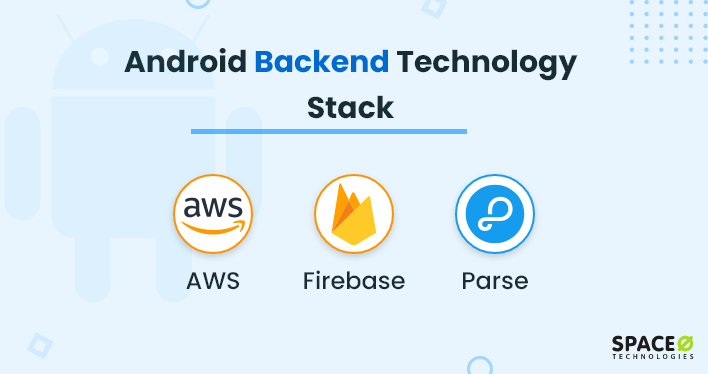
While learning how to build an Android app, it is essential for you to finalize the Android app tech stack. The following table includes the list of Android tech stacks, along with their features and top app examples.
| Android Backend Technology Stack | Description | Features | Examples |
|---|---|---|---|
| AWS | Amazon AWS is a backend server for mobile applications. This serverless and cloud-based backend has everything that you need to power a mobile app. It comes with a broad set of libraries, tools, and features, such as push notifications, cloud data storage, and user authentication, that you need to build an Android mobile application. |
|
|
| Firebase | This other MBaaS solution, Firebase, is approved by Google to build mobile applications. It has a free plan that helps you try its features like real-time database updates, crash reporting, authentification, cloud computing, and hosting of your Android app. |
|
|
| Parse | Parse is one of the popular open-source and self-hosted backend solutions. It offers a software development kit (SDK) that helps a backend developer build mobile apps. It completely works on the CRUD (Create, read, update, delete) philosophy, and majorly, social media apps are the perfect examples of it. |
|
This was all about the tech stacks for the Android applications. We will now discuss the tech stacks you can use for the iOS backend.
iOS Backend Technology Stack
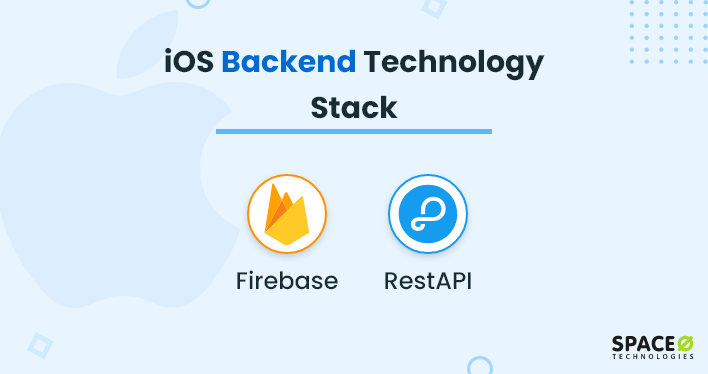
If you are building an iOS app, you need to use the best iOS app development software to build a powerful iOS app. In the following table, we discussed the top tech stacks, their descriptions, features, and examples. Find out the top tech stacks now.
| iOS Backend Technology Stack | Description | Features | Examples |
|---|---|---|---|
| Firebase | Firebase is one of the best backend solutions that also help you develop iOS apps with advanced features like a real-time database, automatic synchronization, push and notifications, social media login, API console, and analytics. |
|
|
| RestAPI | RestAPI offers the best mobile app backend services to build iOS applications. However, with this, you need to repeat your data each time. RestAPI offers the best scalability when compared to other backend tech stacks. |
|
|
Apart from the tech stacks, there are specific tools that help you with the development of mobile app backends. The next section is all about the tools that you can integrate into your app to develop a strong backend.
Tools Used in Mobile App Backend Development
We have listed the top mobile app development tools for back-end development and compared them based on their functionalities, features, and ratings. To successfully perform mobile app backend services, these tools are applied.
| Logo | Backend Development Tools | Features | Reviews (G2) |
|---|---|---|---|
| Apache Tomcat |
| 4.4 104 Reviews | |
| NGINX |
| 4.6 94 Reviews | |
| NodeJS |
| 4.6 14 Reviews | |
| Oracle RDBMS |
| 4.6 378 Reviews | |
| IBM DB2 |
| 4.0 597 Reviews | |
| MySQL |
| 4.4 1575 Reviews | |
| Microsoft Access |
| 4.0 804 Reviews | |
| PostgreSQL |
| 4.4 550 Reviews | |
| MongoDB |
| 4.5 461 Reviews | |
 | Apache JMeter |
| 4.3 124 Reviews |
This list of tools will surely help you to choose the perfect tool for your mobile app backend development based on your project requirements. However, apart from the tools part, you also need to know various app functions that are offered with the backend development. So let’s discuss that in the following section.
Mobile App Functions That are Provided with Backend Development
You need to take care of various things while integrating the backend in the app development. Here are the basic functions that you utilize while developing a mobile app.
| Function | Description |
|---|---|
| Cloud Server | Cloud-based backend servers offer reliability, scalability, accessibility, and centralized management, making them one of the best choices for building mobile apps. In addition, cloud servers have enough physical and network security to help build secured apps. Google App Engine, Microsoft Azure, and Amazon AWS are popular cloud servers that you can use for hosting mobile apps. |
| Software-As-A-Service (SaaS) | It is a special and beneficial add-on to the cloud servers that app developers use for backend development. As a result, you get ready-to-use backend solutions for the front end and back end of apps. Moreover, it is easy to use SaaS-based services just for nominal charges. |
| Custom Servers | If you need custom functionalities or handling critical data, then implementing a custom server to host the mobile app backend is a perfect choice. You have total control over the backend server. However, you would require a dedicated team to manage the work and implement the server. |
Have a Complex App Idea That Requires a Custom Backend?
Talk to us to share your app idea with us. Our technical consultant will validate your app idea and help you build a complex mobile app with a strong backend.
Still, looking to find the backend APIs and mobile app development process of the backend with the mobile? Then, check the below FAQ section where we have answered these questions.
FAQ About Mobile App Backend Development
Which is the fastest backend language?
Java is the most powerful mobile backend language for Android which is replaced by Kotlin is the most utilized language. On the other hand, in iOS app development, Swift is a robust and intuitive programming language to develop apps for iOS, Mac, Apple TV, and Apple Watch.
Which are backend APIs used in mobile apps?
- Back4app
- Parse
- AWS Amplify
- Firebase
- Backendless
Implement a Strong Backend in Your App
Through this blog, you get to learn the various ins and outs of backend development for mobile apps. Now, you know what backend development is, the tools and tech stacks needed to build a strong backend, and how the backend functions.
If you are looking to build an app with a strong backend, then this guide will help you. Also, you can consult with the top mobile app development companies in the USA to build an intuitive frontend and powerful backend for your app.
In fact, at Space-O Technologies, we have helped several clients build powerful backends for their mobile apps. Our experienced app developers will choose the best backend app solution for your mobile app development project. Contact us today to know more about how our mobile app backend development services can benefit your app project.
